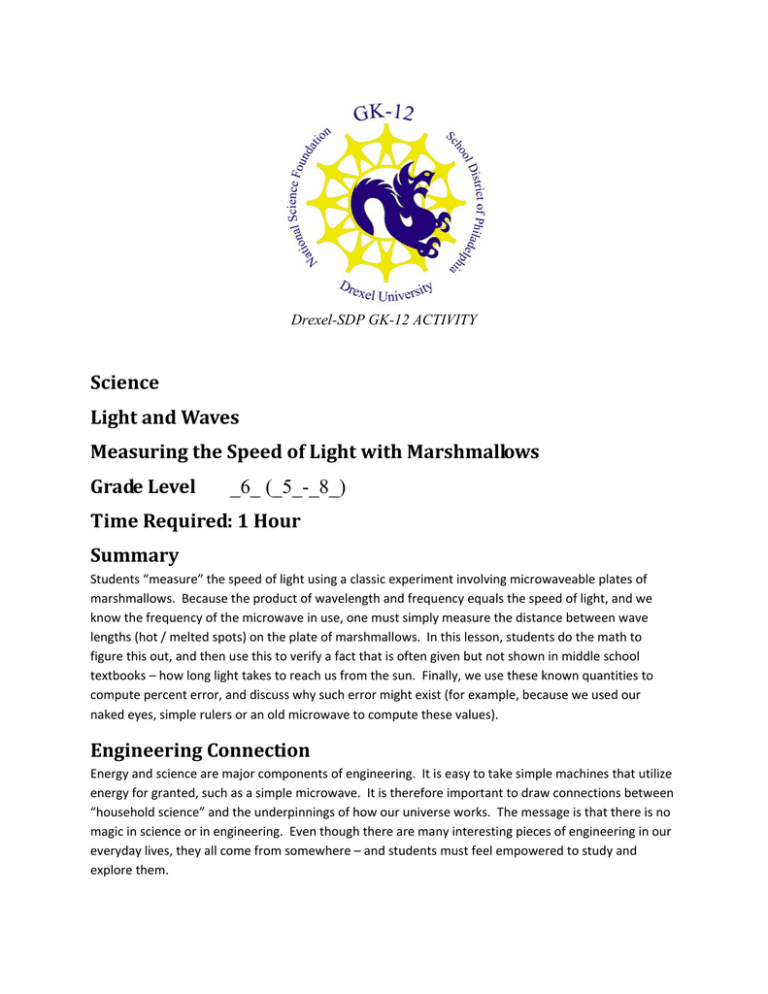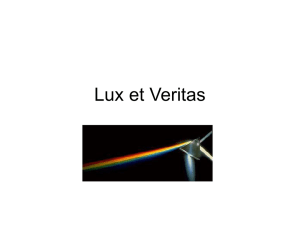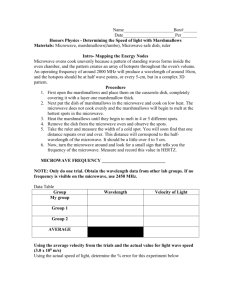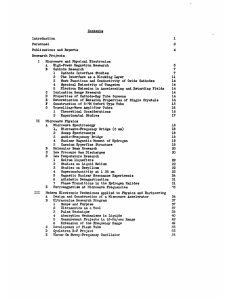advertisement

Drexel-SDP GK-12 ACTIVITY Science Light and Waves Measuring the Speed of Light with Marshmallows Grade Level _6_ (_5_-_8_) Time Required: 1 Hour Summary Students “measure” the speed of light using a classic experiment involving microwaveable plates of marshmallows. Because the product of wavelength and frequency equals the speed of light, and we know the frequency of the microwave in use, one must simply measure the distance between wave lengths (hot / melted spots) on the plate of marshmallows. In this lesson, students do the math to figure this out, and then use this to verify a fact that is often given but not shown in middle school textbooks – how long light takes to reach us from the sun. Finally, we use these known quantities to compute percent error, and discuss why such error might exist (for example, because we used our naked eyes, simple rulers or an old microwave to compute these values). Engineering Connection Energy and science are major components of engineering. It is easy to take simple machines that utilize energy for granted, such as a simple microwave. It is therefore important to draw connections between “household science” and the underpinnings of how our universe works. The message is that there is no magic in science or in engineering. Even though there are many interesting pieces of engineering in our everyday lives, they all come from somewhere – and students must feel empowered to study and explore them. Keywords • Marshmallows • Light • Information • Energy • Waves PA Science Educational Standards • 2.3 Measurement and Estimation • 3.4.7B Relate energy sources and transfers to heat and temperature • 3.4.7C Identify and explain the principles of force and motion Materials • 2450 MHz microwave (others are possible but note the difference in the worksheet for doing the math) • A microwave‐safe plate • Bag of marshmallows • Ruler • Calculator (optional) Procedure Your science textbook likely says that it takes 8.3 minutes for light to reach the earth from the sun. How did they figure this out? How fast does light travel? Distance is your speed times the time, so if I can walk at 3 steps per second, and I walk for 2 seconds, I have taken 3 x 2 = 6 steps. Or, if my car goes 60mph, and I drive for 2 hours, how far have I gone? Using this and a microwave, we will figure out the speed of light. And from that, we will figure out how long it really takes for light to reach us from the sun. A microwave has a frequency of 2450MHz, meaning that waves inside the microwave occur 2450 million times per second. But what about the distance that each wave “travels?” To figure this out, we will microwave a plate of marshmallows. Where the marshmallows “puff up” is the beginning of a wave. So the distance between these warm spots is the “distance.” Microwave Frequency X Distance Between Warm Spots (cm) X = Speed of Light (meters per second) 1000000 .01 Question: Why did we multiply by an extra one million, and an extra one hundredth? The actual speed of light is about 299,792,458 meters per second. How might we translate this into miles per hour? What distance between the marshmallow spots would have given you 299,792,458? How close was your answer to the “actual answer?” Microwave Frequency X Distance Between Warm Spots (cm) 1000000 X = .01 Speed of Light (meters per second) 299792458 Finally, how can we use our speed of light to figure out how long it takes light to reach us from the sun? The earth is 93,000,000 miles away, which is 150 million kilometers. Once you find these numbers, what do you have to do with them to figure it out (add/subtract/multiply/divide?). Also, like we did before, be sure to express your distance in meters (I gave you millions of kilometers!), and your speed of light in meters per second. Your answer will be in seconds – convert it to minutes in the table. Distance (meters) Speed of Light (meters per second) = Time Light Takes to Reach Us (seconds) Time Light Takes to Reach Us (minutes) How close is the book to this answer? To find the percent error, you can do: (Your Answer – Book Answer) ‐‐‐‐‐‐‐‐‐‐‐‐‐‐‐‐‐‐‐‐‐‐‐‐‐‐‐‐‐‐‐‐‐‐‐‐‐‐‐‐ Your Answer Think of light as information, like in a computer, or a microwave. The light we see from the ceiling in our room is not actually the light that is happening “right now.” It’s the light that happened a tiny fraction of a second ago. But if light really takes 8.3 minutes to reach us from the earth, then the sun we see is really the sun as it existed 8.3 minutes ago! In a way, it’s not the “real sun.” If the sun disappeared (like a sunset), we wouldn’t notice it for another 8.3 minutes. So when we finally see the sunset, the sun had really set about 8 minutes ago, but the information hadn’t reached us yet. Would it take longer to send an email to Hong Kong or to New York and why? Author William M. Mongan, Jason Coleman Date: 7/6/2008 Copyright Copyright 2007 Drexel University GK12 Program. Reproduction permission is granted for non‐profit educational use




